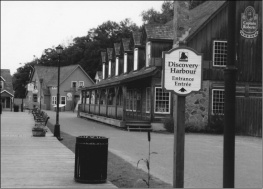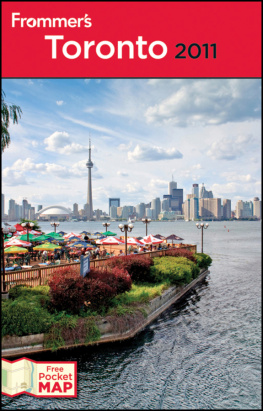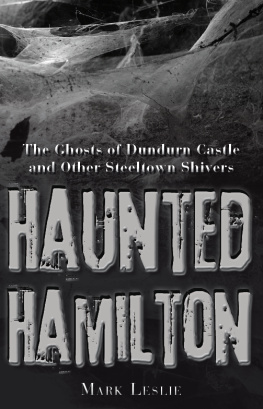Haunted Toronto
John Robert Colombo
OTHER BOOKS ABOUT MYSTERIES BY THE SAME AUTHOR
They are the best collections of their kind
being produced by anyone, anywhere, so far as I can see.
(Hilary Evans, on the Personal Accounts Series)
Colombos Book of Marvels
(Toronto: NC Press, 1979)
Windigo
(Saskatoon: Western Producer Prairie Books, 1982)
Mysterious Canada
(Toronto: Doubleday Canada Limited, 1988)
Extraordinary Experiences
(Toronto: Hounslow Press, 1989)
Mysterious Encounters
(Toronto: Hounslow Press, 1990)
Mackenzie Kings Ghost
(Toronto: Hounslow Press, 1991)
UFOs over Canada
(Toronto: Hounslow Press, 1991)
Dark Visions
(Toronto: Hounslow Press, 1992)
The Little Blue Book of UFOs
(Vancouver: Pulp Press, 1992)
The Mystery of the Shaking Tent
(Toronto: Hounslow Press, 1993)
Strange Stories
(Toronto: Colombo & Company, 1994)
Ghosts Galore!
(Toronto: Colombo & Company, 1994)
Close Encounters of the Canadian Kind
(Toronto: Colombo & Company, 1994)
Ghost Stories of Ontario
(Toronto: Hounslow Press, 1995)
HAUNTED
TORONTO
John Robert
Colombo

Haunted Toronto
Copyright 1996 by John Robert Colombo
All Rights Reserved. No part of this publication may be reproduced, stored in a retrieval system, or transmitted in any form or by any means, electronic, mechanical, photocopying, recording, or otherwise (except brief passages for the purposes of review) without the prior permission of Hounslow Press. Permission to photocopy should be requested from the Canadian Reprography Collective.
Hounslow Press
A member of the Dundurn Group
Publisher: Anthony Hawke
Editor: Liedewy Hawke
Designer: Sebastian Vasile
Printer: Webcom
Canadian Cataloguing in Publication Data
Colombo, John Robert, 1936
Haunted Toronto
Includes bibliographical references.
ISBN 0-88882-185-9
1. Ghosts - Ontario - Toronto. 2. Haunted houses
Ontario - Toronto. I. Title.
BF. C3C65 1996 133.1'2'09713541 C96-930606-7
Publication was assisted by the Canada Council, the Book Publishing Industry Development Program of the Department of Canadian Heritage, and the Ontario Arts Council.
Care has been taken to trace the ownership of copyright material used in this book. The author and the publisher welcome any information enabling them to rectify any references or credit in subsequent editions.
Printed and bound in Canada
Hounslow Press
2181 Queen Street East
Suite 301
Toronto, Ontario, Canada
M4E 1E5 | Hounslow Press
73 Lime Walk
Headington, Oxford
England
OX3 7AD | Hounslow Press
250 Sonwil Drive
Buffalo, NY
U.S.A. 14225 |
CONTENTS
To the Memory of William Kilbourn
Historian, Torontonian, Humanist
Canada needs ghosts, as a dietary supplement, a vitamin taken to stave off that most dreadful of modern ailments, the Rational Rickets.
Robertson Davies, Preface, High Spirits (1982), a collection of ghost stories set in Massey College.
The character of a place is often most perfectly expressed in its associations. An event strikes root and grows into a legend, when it has happened amongst congenial surroundings. Ugly actions, above all in ugly places, have the true romantic quality, and become an undying property of their scene.
Robert Louis Stevenson, Legends, Edinburgh: Picturesque Notes (1879)
There is nothing supernatural about ghosts. They are part of the world in which we live and they follow laws which we are beginning to understand more fully as more and more research into parapsychology continues to be done.
Robin Skelton and Jean Kozocari, from their book about ghost-busting, A Gathering of Ghosts (1989)
Ive not seen a ghost. Theyve never been able to capture one, you know. But Ive been one Ive haunted a lot of lives.
Allan Lamport, Metros Goldwyn Mayor, obiter dictum, 8 July 1995
Preface
Haunted Toronto: A Ghosthunters Guide?
Yes, of course!
This is the first book to be researched and written about the citys spirits and haunts. There have been newspaper stories and magazine articles a plenty, but so far no books. This book deals with ghosts and spirits, apparitions and poltergeists, wraiths and spectres, haunted houses and shunned sites, folklore and urban lore, strange events and peculiar experiences, the supernatural and the parapsychological. It deals with the eerie. It gives locations, descriptions, and sources. It covers all of Metropolitan Toronto, not just the City of Toronto. It begins in prehistory and continues through the historical period right up to the New Age of the 1990s.

Author John Robert Colombo, shown in this photo taken in 1987, is leaning against a stone marker which bears the explanatory words The Birthplace of Modern Spiritualism. The marker identifies the site of the Hydesville Cottage in Upstate New York where two Upper Canadian farm girls, Maggie and Katie Fox, inadvertently launched the Spiritualist movement on 31 March 1848, and thus embarked on careers that made the two of them the most famous or infamous mediums of the nineteenth century.
[Hawkshead Services]
Toronto is interestingly named. The official meaning of the name is place of meaning in the language of the Huron Indians. Toronto may thus be said to be a place where human beings encounter the known and the unknown.
Why Toronto?
There are ancient places that have been continuously occupied for thousands of years. Records show that such sites as Babylon, in present-day Iraq, and Third Mesa, the traditional home of the Hopi in Arizona, have been occupied for six thousand or more years. Toronto is not among such ancient places. Yet neither is it a newcomer among communities. It is no Brasilia. Well before the Renaissance in Italy, there were people living on the northern shore of Lake Ontario. All established cities have their own resident spirits, or at least their own traditions of hauntings. Toronto is an established city and has them too, as the entries in this book show. Perhaps it is time that Torontonians paid attention to them.
Some early inhabitants of todays Toronto were people of sensitivity, sophistication, and worldly experience. They were comfortable with the cultures of the Old Country and the possibilities of the New World. For instance, the prose and poetry of the great German poet Goethe were being read in their original language with sympathy and understanding in Little York within four years of the poets death in Weimar in 1832. The Goethe-reader was the colonial writer Anna Brownell Jameson who enjoyed the poets works and showed a fine appreciation of how Goethe made dramatic use of legend and myth in a haunting ballad like The Erl King which he based on local supernatural lore. Mrs. Jameson was sympathetic to the arts but also to the beauty and wonder of the new land, especially the traditional lore of its native people. Indeed, the Indians of Manitowaning Reserve on Manitoulin Island granted her that rare distinction, an Indian name. They called her
Next page





